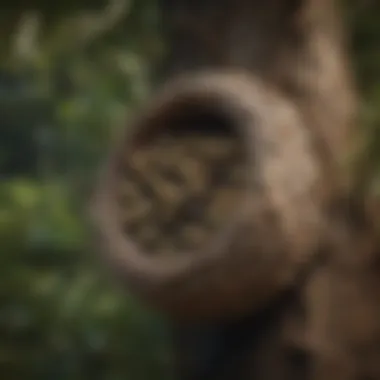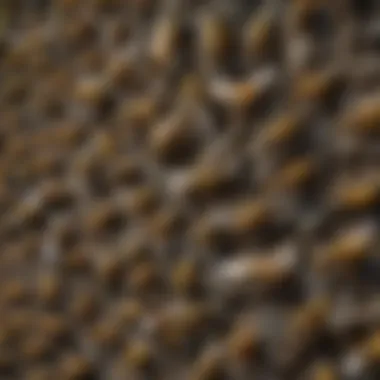Effective Strategies for Managing Wasp Populations


Intro
Wasp populations have steadily increased in residential areas, leading to concerns among homeowners. As these insects become more common in backyards, understanding how to manage their presence becomes crucial. The presence of wasps can disrupt outdoor enjoyment, particularly during social gatherings and family activities. However, wasps also play a vital role in the ecosystem, making management challenging.
Effective management requires knowledge of the reasons behind wasp attraction to residential spaces. Factors such as available food resources, suitable nesting spots, and environmental changes play significant roles in their proliferation. By addressing these elements, homeowners can develop strategies to either coexist with or remove these insects safely.
This article aims to offer a thorough exploration of wasp management in residential areas. It will touch on ecological roles and associated risks, alongside practical management tips. Readers can expect a mix of insights from experts in pest control and practical advice drawn from proven methods.
Understanding Wasp Populations
Understanding wasp populations is a critical first step in effectively managing them, especially in residential areas. Wasps, while often viewed negatively, play significant ecological roles. Thus, a balanced perspective on their presence is necessary. By recognizing the various species, their behavior, and their lifecycle, residents can make informed decisions about management strategies.
Species of Wasps Commonly Found
Yellowjackets
Yellowjackets are perhaps the most recognizable wasp species in urban settings. They are known for their distinctive bold black and yellow markings. These wasps are highly social, living in colonies that can number in the thousands. Their aggressive nature, especially when their nests are disturbed, can be alarming. However, they are also beneficial as they control pest populations. Yet, their proximity to human activity frequently leads to conflicts. Understanding their behaviors and habitats is crucial for mitigating potential risks.
Paper Wasps
Paper wasps, characterized by their elongated bodies and loosely constructed nests, are generally less aggressive than yellowjackets. These insects typically build their nests under eaves and in sheltered areas. They serve as natural predators of caterpillars and other garden pests, making them advantageous for gardeners. However, their nests can become a nuisance, especially if located near human activity. Recognizing their presence and behavior can help homeowners decide whether to coexist or remove them.
Baldfaced Hornets
Despite their name, baldfaced hornets are actually a type of wasp. Recognizable by their black and white coloration, these insects are known for constructing large, aerial nests. They are protective of their nests and can be quite aggressive if threatened. Like yellowjackets, they are voracious predators of other insects. Understanding their nesting habits and behavior is essential, as it allows residents to take precautions during outdoor activities in the vicinity of their nests.
Life Cycle and Behavior
Nest Building
Nest building is a fascinating aspect of wasp behavior. Most wasp species construct nests made from chewed wood fibers mixed with saliva, resulting in a papery material. This characteristic is particularly prevalent in paper wasps and baldfaced hornets. The location and construction of these nests are vital. A well-placed nest can thrive throughout the summer but poses risks to nearby human activities when disturbed. Understanding their nesting behavior helps with anticipation and prevention strategies.
Feeding Habits
Wasp feeding habits are diverse. Most wasps are omnivorous, scavenging for both protein-rich substances, like other insects, and sugary foods. This dietary flexibility allows wasps to thrive in various environments. Understanding what attracts them can assist homeowners in minimizing their presence. For example, placing garbage bins tightly closed and cleaning up spilled food can reduce attractants.
Winter Survival Strategies
In cooler months, wasps display unique survival strategies. Most worker wasps die off in winter, with only fertilized queens hibernating. These queens seek sheltered spots, often in residences, to survive until spring. Knowing this can be beneficial for homeowners, who can take preventive measures during the fall, such as removing potential nesting sites to keep future populations in check.
Understanding the lifecycle and behavior of wasps can help to mitigate risks while also considering their ecological contributions. By knowing their habits, homeowners can avoid conflict and maintain harmony in their outdoor spaces.
Reasons for Increased Wasp Populations
Understanding the factors contributing to heightened wasp populations is essential for homeowners and gardening enthusiasts. By deciphering these elements, residents can better manage their yards and outdoor activities, ensuring safety and enjoyment. This section highlights key environmental aspects and food source availability that encourage these insects to thrive in residential areas.
Environmental Factors
Climate Change Impacts
Climate change is reshaping ecosystems worldwide. The warmer temperatures can lead to increased wasp activity and longer seasons. Higher temperatures promote an earlier emergence of colonies in spring and a prolonged period of foraging in fall. As a result, wasps are more likely to be present during human outdoor activities. Homeowners may notice more wasps than in seasons past. Adapting strategies to counteract this trend becomes necessary as climate effects persist.
Seasonal Variations
Each season brings distinct changes that affect wasp populations. For instance, during summer, the availability of food sources spikes due to blooming flora. This abundance fuels population growth, as increased food supports colonies and helps them thrive. Additionally, variations in precipitation and temperature can modify nesting patterns, influencing where wasps establish nests in residential areas. These seasonal changes need to be monitored to anticipate wasp presence.
Urbanization Effects
Urban environments often provide ideal conditions for wasps due to artificial habitats. Buildings, eaves, and other structures present nooks for nests. The availability of food sources, such as city parks and outdoor dining spaces, attracts wasps to human habitats. Urbanization also leads to fragmented natural habitats, limiting wasps’ predation options and enhancing their populations in residential spaces. Recognizing these urban challenges is crucial for effective management of wasps.
Food Sources


Availability of Natural Food
Natural food sources are vital for the sustenance of wasp populations. They primarily feed on other insects, fruit, and nectar. A rich environment teeming with flowers increases the likelihood of wasps being present in the area. Homeowners with robust gardens can inadvertently support wasp growth, as an abundance of food contributes to the healthy size of colonies. Adjusting landscaping can help control this.
Human Waste and Outdoor Eating
Human activities significantly influence wasp populations. Outdoor dining, parties, and picnics generate food waste that attracts wasps. Unattended trash cans and leftover food can lead to an influx of these insects. Homeowners need to maintain proper waste disposal practices and clean outdoor areas after social gatherings. This reduction in easily accessible food sources can be a significant deterrent against wasps lingering around.
Gardens and Flowering Plants
Gardens filled with specific flowering plants can both attract and deter wasps. Plants like daisies and asters not only draw in wasps but also other beneficial pollinators. Conversely, choosing plants that repel wasps, such as lemongrass and citronella, can create more balanced ecosystems. Understanding the relationship between plant choices and wasp attraction is vital for homeowners wishing to minimize wasp presence while still enjoying a vibrant garden.
Key Takeaway: Understanding the factors behind increased wasp populations can empower homeowners to take proactive measures to manage their yards effectively. Engaging in informed actions can mitigate the impact of these insects on outdoor activities and overall enjoyment.
Risks Associated with Wasp Presence
Understanding the risks associated with wasp presence is crucial in navigating the challenges they pose in residential areas. The dangers can range from health-related issues to disruptions in outdoor activities. By recognizing these risks, homeowners can take informed actions to mitigate potential threats and plan effective management strategies. Moreover, an awareness of the consequences can enhance the enjoyment of outdoor spaces, ensuring that families and visitors can engage without fear.
Health Risks
Stings and Allergic Reactions
Wasp stings can range from merely painful to severely harmful. For many individuals, a sting causes momentary discomfort and swelling. However, for some, it can trigger significant allergic reactions. This points to the first concern: ensuring a safe environment for everyone is essential.
A key feature of wasp stings is their pain-inducing nature, which often leads to general anxiety around outdoor activities. This situation becomes particularly problematic for those unaware of their allergic status. The benefit of addressing this issue is that it allows communities to implement preventative measures, such as education about avoidance and treatment methods. By raising awareness, individuals gain a deeper understanding of what to expect and how to respond in case of a wasp sting.
Anaphylaxis Risks
Anaphylaxis represents the most extreme allergic reaction to wasp stings, leading to potential life-threatening situations. Its sudden onset requires immediate medical attention. The unique element of this risk lies in its unpredictable nature; even those who have been stung before without an issue may experience anaphylaxis upon subsequent stings.
The presence of this risk serves as a critical reminder for homeowners to remain vigilant and prepared. Carrying an epinephrine auto-injector can be life-saving. Addressing anaphylaxis risks enhances the article’s objective by emphasizing the necessity of preparedness when dealing with wasps. This could involve informing neighbors about the importance of recognizing the signs of severe allergic reactions and establishing a community protocol for emergencies.
Impact on Vulnerable Populations
Certain groups in the community are more susceptible to the risks posed by wasps. Individuals with pre-existing allergies, children, and the elderly are particularly vulnerable. Understanding this impact is vital to creating safe outdoor environments where everyone feels included.
Highlighting vulnerable populations underscores the need for tailored approaches to wasp management. Increased community awareness about these potential dangers fosters a sense of collective responsibility. Consequently, neighbors might collaborate more closely to identify instances of wasp nests, share strategies for removal, and prevent dangerous situations. This way, the overall safety within residential areas can improve significantly.
Impact on Outdoor Activities
Disruption of Family Gatherings
Outdoor gatherings are essential for building community and socializing, yet wasps can threaten this experience. A gathering's tranquility can quickly dissipate in the face of aggressive wasps, leading to discomfort or even danger. This disruption changes the dynamics of family and friend interactions.
By recognizing the influence of wasps on outdoor events, homeowners can take proactive measures. Simple strategies, such as timing gatherings later in the evening when wasp activity peaks have decreased, may prevent unwarranted interruptions. Furthermore, educating guests about remaining calm during a sighting can help ensure a more enjoyable atmosphere.
Limitations on Gardening and Outdoor Work
Wasps can greatly hinder gardening activities. Homeowners may become reluctant to tend to their gardens or perform essential outdoor tasks, fearing potential encounters. This avoidance can lead to neglected outdoor spaces and reduce overall enjoyment of one’s home environment.
The challenge lies in finding a balance between protecting gardens and managing wasp populations effectively. Implementing proper garden design, such as avoiding attractants, can reduce wasp presence. Additionally, leveraging barriers between gardening spaces and nesting areas may allow homeowners to enjoy their love for gardening without constant worry over wasp interactions.
Emotional Distress for Individuals
The presence of wasps can lead to anxiety, affecting individuals’ overall wellbeing. People may develop a strong aversion to outdoor settings, which limits their quality of life. Emotional distress linked to potential stings can deter participation in normal social activities.
Addressing this emotional aspect is important. Knowledge of strategies to manage wasp populations not only informs but empowers individuals, allowing them to reclaim their outdoor spaces. Understanding options for coexistence and removal instills confidence, thus transforming outdoor experiences from fear-laden to enjoyable and inviting.
Recognizing and addressing the risks posed by wasps allows communities to take collective responsibility and ensure safer outdoor environments.
Identifying Wasps in Your Backyard


Identifying wasps in your backyard is foundational to effective management strategies. Recognizing these insects early can prevent potential dangers before they escalate. Understanding their physical traits and behaviors aids homeowners in distinguishing them from bees and other beneficial insects. Moreover, identifying wasps can clear uncertainties about safety and ecological impacts, leading to informed decisions on managing their presence.
Signs of Nesting
Recognizing signs of nesting can be critical for effective wasp management. Nests can indicate the presence of wasps, which often require a proactive approach.
Visible Nests in Trees or Eaves
Visible nests are often located in areas such as trees or eaves. A key characteristic of these nests is their papery appearance, made from chewed wood fibers. These nests often appear round or oval-shaped, sometimes growing quite large. Seeing a nest early can be advantageous because it allows for planning removal before wasps become aggressive. Distinguishing nests in these common locations is essential for any homeowner wanting to control wasp populations effectively.
Increase in Wasp Activity
An increase in wasp activity often signals a nearby nest. This behavior typically shows up as more wasps flying in the area, especially in late summer and early fall. A significant buzz around garbage bins or flower gardens often suggests wasps are foraging for food. Such behavior is beneficial to note, giving insight into where potential nests may lie. More wasps may also mean more potential threats, urging immediate identification and action by the homeowner.
Presence of Dead Wasps
Finding dead wasps around your property can indicate an active nest nearby. Their presence might suggest several scenarios, including predator activity or unsuccessful attempts to invade a home. Observing dead wasps can convey critical information about the population dynamics in your area. This can be useful in assessing whether the nests are being targeted, providing a clearer understanding to homeowners on how to proceed with their management strategy.
Distinguishing from Bees
It is crucial to distinguish wasps from bees, as their management approaches vary. Recognizing their distinct characteristics can avoid unnecessary hazards and promote a balanced ecosystem.
Physical Differences
One notable aspect of physical differences is that wasps tend to have smoother bodies compared to the hairy bodies of bees. The coloration also differs; many wasps exhibit bright patterns of yellow and black. Understanding these physical traits helps in proper identification, which is essential for managing their populations effectively. Identifying them can also decrease the risk of stings, as homeowners can take appropriate action.
Behavioral Characteristics
Behaviorally, wasps tend to be more aggressive, especially when their nests are threatened. Unlike bees, which often defend their colonies but may die after stinging, wasps can sting multiple times. Recognizing these dynamics aids homeowners in assessing risks during outdoor activities. Identifying these behavioral markers ensures safety particularly when family and guests are present.
Habitat Preferences
Lastly, wasps favor areas that provide food and shelter, which includes gardens, trees, and buildings. They often build nests in sheltered locations like under the eaves of houses. Homeowners should consider this when planning landscaping, ensuring that such areas do not become attractive to wasps. Being mindful of where these insects prefer to build can help in effective management over time.
Effective Management Strategies
Effective management strategies are vital in addressing the challenges posed by wasp populations in residential areas. Proper techniques ensure not only the safety of residents but also maintain harmony in outdoor spaces. The essence of these strategies involves proactive measures that reduce the likelihood of establishing wasp nests while providing safe approaches for removal when necessary.
Preventive Measures
Preventive measures are centered on reducing the likelihood of wasps nesting near homes. These strategies reduce potential conflict between humans and wasps, ensuring a more pleasant outdoor experience.
Reducing Food Sources
Reducing food sources is a key aspect of controlling wasp populations. Wasps are attracted to sugary substances and protein sources. To achieve this, homeowners should keep outdoor dining areas clean from food debris and ensure garbage bins are tightly sealed. This method is beneficial because it minimizes the allure of nearby food sources that attract wasps. Additionally, focusing on cleanliness and food storage can lead to fewer encounters with these insects. However, the disadvantage is the need for consistent diligence; failing to maintain cleanliness can result in a resurgence of wasps.
Nest Deterrents
Nest deterrents play a crucial part in effective management strategies. These are measures designed to make locations less appealing for wasps to build nests. For instance, hanging fake nests or using specific scents can prevent wasps from settling in. The key characteristic of this method is its proactive approach, which aims to discourage nesting before it happens. This choice can be popular due to its non-chemical nature, making it safe for families and pets. Yet, a unique downside is that effectiveness may vary based on the species and environmental factors.
Regular Inspections
Regular inspections are important for identifying potential wasp nesting sites early. Homeowners should routinely check eaves, sheds, and other areas where nests may be formed. This characteristic of proactive monitoring contributes significantly to overall safety. By detecting nests early, it is possible to take action before they become larger or more dangerous. The advantage of this strategy is early intervention; however, it requires a commitment to ongoing observation, which some people might overlook.
Safe Removal Techniques
In certain situations, removal of wasps and their nests may become necessary. This section covers safe and practical methods to handle wasp populations effectively.
DIY Traps and Baiting Methods
DIY traps and baiting methods represent a cost-effective solution homeowners can use to manage wasp populations. These traps typically involve a container with bait that attracts wasps, allowing for their capture. The primary strength of this method lies in its accessibility; many homeowners can create traps from household items. However, while effective, these traps might not address larger colonies and may require consistent monitoring to maintain effectiveness.


Professional Extermination Services
Professional extermination services provide a reliable option for homeowners dealing with larger or more aggressive wasp nests. Experts in pest control have the experience and specialized tools to safely remove threats. This is a beneficial and popular choice as it removes the risk of stings and ensures proper handling of nests. However, the unique feature of this method is the cost involved; hiring professionals might not be feasible for all homeowners.
Timing Considerations for Removal
Timing considerations for removal are crucial to effective management of wasp populations. The ideal time for removal is typically late at night or early in the morning when wasps are less active. This strategic timing helps reduce the risk of stings for those attempting removal. The advantage of this method is the safer approach it offers, allowing for more cautious preparations. However, the drawback may include limited windows for effective removal, as homeowner schedules can conflict with optimal conditions.
"Proactive management and safe removal techniques are essential to minimize wasp encounters and ensure a peaceful outdoor living environment."
Each of these strategies contributes to the overall goal of managing wasp populations effectively, allowing homeowners to enjoy their outdoor spaces without fear of conflict with these insects.
Coexisting with Wasps
Coexisting with wasps is critical for homeowners and residents who wish to maintain a pleasant outdoor experience. These insects often cause distress due to their stings and aggressive behavior when nests are disturbed. However, understanding their role in the ecosystem and implementing strategies for coexistence can significantly reduce conflicts between humans and wasp populations.
By recognizing the benefits wasps bring, such as natural pest control and pollination, individuals can learn to mitigate the risks associated with their presence without resorting to extermination. Moreover, creating environments that deter nesting while promoting beneficial interactions fosters a more harmonious relationship with these insects.
Understanding Their Role in Ecosystems
Pollination Contributions
Wasps play an important role in pollination, although not as prominent as bees. They are attracted to certain flowering plants for nectar. While feeding, they inadvertently transfer pollen from one flower to another, facilitating plant reproduction. This contribution helps maintain the biodiversity of gardens and landscapes.
Their unique behavior as opportunistic feeders means they often visit various flowers, increasing the genetic diversity of plant species. This aspect makes it valuable for horticultural settings. However, the extent of their impact on overall pollination is less compared to bees, which can be a disadvantage in ecosystems dependent on specific pollen carriers.
Pest Control Advantages
One significant advantage of wasps is their role as natural pest controllers. Many species feed on insects like caterpillars, flies, and aphids. This helps keep these pest populations in check, benefiting gardens and agricultural areas. Wasps, especially yellowjackets, are known to catch and paralyze prey to feed their larvae, thus reducing the number of harmful insects.
Their hunting behavior provides a natural solution for pest reduction. This aspect can reduce the need for chemical pesticides, which have adverse effects on other beneficial insects and the environment. The downside is that a local rise in wasp populations may lead to more stings and hostility if nests are nearby.
Food Source for Other Wildlife
Wasps serve as a food source for various wildlife species, including birds and small mammals. Their life cycle, which includes becoming a part of the food web, supports local ecosystems. Declines in wasp populations can impact the creatures that rely on them for sustenance. Understanding this aspect is critical in witnessing the interconnectedness of ecological systems.
The unique feature of wasps being both predators and prey emphasizes their dual role. While they can pose a danger due to their stings, their contributions to biodiversity support more extensive food chains. The disadvantage appears when populations fluctuate, potentially affecting those species dependent on them, leading to ecological imbalances.
Creating Wasp-Friendly Spaces
Designing Gardens to Deter Nesting
Designing gardens with the objective of deterring wasps from nesting can be a proactive approach. Specific tactics include planting certain plants that are less attractive to wasps and keeping areas clean from food debris. Using physical barriers, such as netting or specific landscaping designs, can also reduce nesting chances.
One notable characteristic is the placement of these gardens away from common feeding or nesting sites, which helps manage local wasp populations. However, while creating these deterrents can be effective, it requires regular maintenance and observation.
Choosing Plants That Attract Beneficial Insects
In addition to deterring wasps, selecting the right plants can attract beneficial insects that enhance the garden's ecosystem. Flowers such as marigolds and borage attract pollinators and predatory wasps, which naturally regulate pest populations. This strategy promotes a balanced ecosystem while reducing the chance of wasps becoming a nuisance.
A key benefit is that these plants often offer year-round appeal, attracting various beneficial creatures. However, gardeners should be mindful of their choices as some species may end up inviting unwanted wasp populations, which could lead to conflicts.
Using Natural Barriers
Incorporating natural barriers can help manage wasp presence without harming them. Placing shrubs, dense foliage, or other landscaping elements can shield areas where children play or outdoor dining occurs. These barriers can make it more difficult for wasps to access these spaces, promoting a safer outdoor experience.
Natural barriers are a beneficial and organic approach to coexistence. They enhance your garden's aesthetics while providing defensive elements against wasps. The downside is that physical barriers must be carefully placed and maintained to ensure effectiveness, sometimes requiring alterations over time.
Closure
Understanding the complexities of these insects informs effective management strategies. Homeowners can mitigate conflicts by implementing preventive measures, recognizing signs of nesting, and knowing when to seek professional help. Such practices not only enhance the safety and enjoyment of outdoor spaces but also acknowledge the ecological importance of wasps.
A balanced approach that allows for coexistence while managing risks is crucial for homeowners, interior design enthusiasts, party hosts, and gardening aficionados. Ignoring the potential impact of rising wasp populations may lead to increased disruptions in outdoor activities and emotional distress for individuals.
"Effective management of wasp populations not only secures our outdoor experiences but also promotes biodiversity in our backyards."
Ultimately, fostering a deeper understanding of wasps, their behaviors, and their contributions to the environment is essential. By adapting our practices to suit local ecosystems, we can enjoy our outdoor spaces while respecting the roles of the various species within them.



